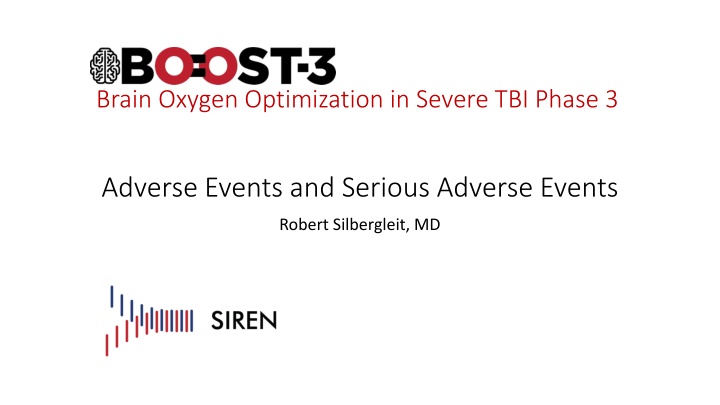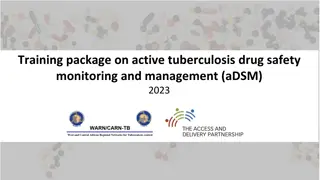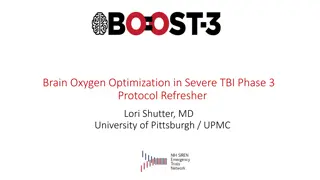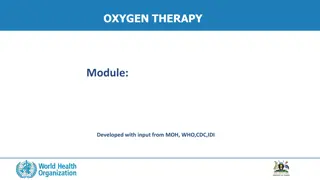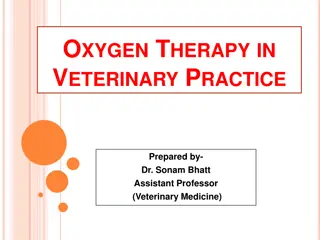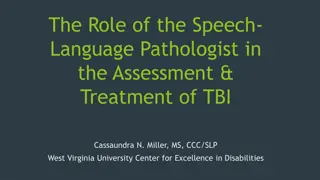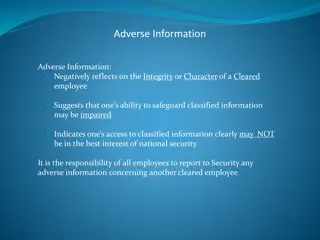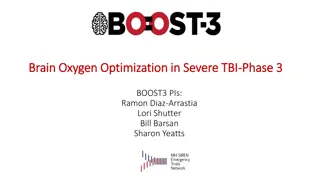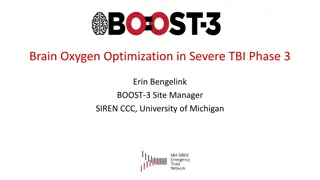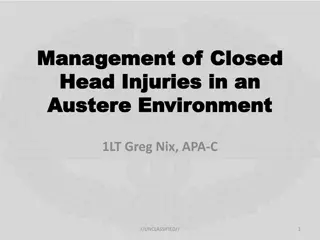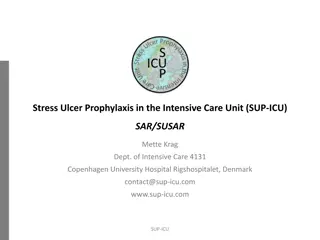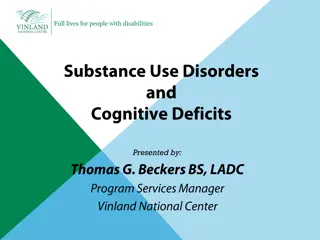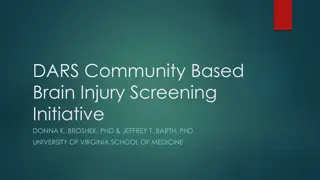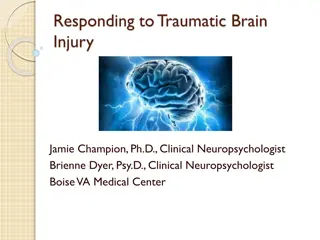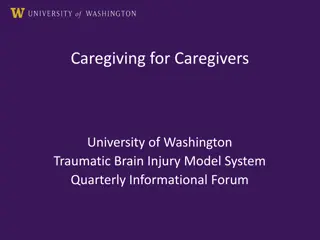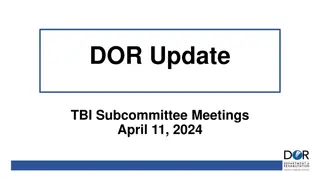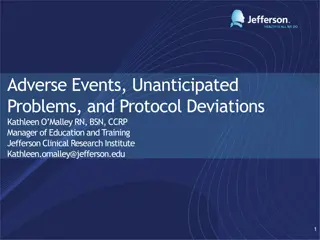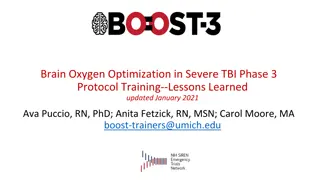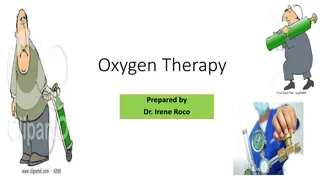Brain Oxygen Optimization in Severe TBI: Adverse Events Analysis
This study led by Dr. Robert Silbergleit focuses on adverse events in brain oxygen optimization for severe Traumatic Brain Injury (TBI) patients. It outlines key points for reporting adverse events, discusses relatedness algorithms, and presents scenarios to analyze adverse events occurrence post-enrollment in the BOOST study. The cases involve seizures, anticonvulsant treatments, and EEG monitoring to evaluate adverse events and their relatedness to the intervention.
Download Presentation

Please find below an Image/Link to download the presentation.
The content on the website is provided AS IS for your information and personal use only. It may not be sold, licensed, or shared on other websites without obtaining consent from the author.If you encounter any issues during the download, it is possible that the publisher has removed the file from their server.
You are allowed to download the files provided on this website for personal or commercial use, subject to the condition that they are used lawfully. All files are the property of their respective owners.
The content on the website is provided AS IS for your information and personal use only. It may not be sold, licensed, or shared on other websites without obtaining consent from the author.
E N D
Presentation Transcript
Brain Oxygen Optimization in Severe TBI Phase 3 Adverse Events and Serious Adverse Events Robert Silbergleit, MD
Adverse Events key points Do not report events EXISTING PRIOR to randomization (unless there is a change in severity) Report the DIAGNOSIS, not the symptoms: Fever, cough, chest pain, crackles = pneumonia Report the PATHOLOGY, not the outcome or treatment Not death but the event that caused death CD
Relatedness Relatedness algorithm Not Related The timing is wrong and there was clearly another cause Reasonable Possibly (2 of 3) Timing is suggestive. Not readily caused by something else This is something the intervention is known to cause. Unlikely (both of the following, but timing doesn t matter) Another cause is possible Not something the intervention is known to cause Definitely (must have all 3) Timing suggests intervention caused the problem. No other possible cause. This is something the intervention is known to cause.
While being screened for enrollment in BOOST, a 52 yo with TBI from a MVC has a prolonged seizure requiring treatment which resolves after several rounds of anticonvulsants. She is subsequently appropriately enrolled. Anticonvulsant medications are continued after enrollment as is continuous EEG monitoring. Adverse event? Serious? Expected? Yes / No Yes / No Yes / No Related? A. Not related B. Unlikely C. Reasonable Possibly D. Definitely
While being screened for enrollment in BOOST, a 52 yo with TBI from a MVC has a prolonged seizure requiring treatment which resolves after several rounds of anticonvulsants. She is subsequently appropriately enrolled. Anticonvulsant medications are continued after enrollment as is continuous EEG monitoring. Brief electrographic seizures are seen. No AED are added or changed. Adverse event? Serious? Expected? Yes / No Yes / No Yes / No Related? A. Not related B. Unlikely C. Reasonable Possibly D. Definitely
While being screened for enrollment in BOOST, a 52 yo with TBI from a MVC has a prolonged seizure requiring treatment which resolves after several rounds of anticonvulsants. She is subsequently appropriately enrolled. Despite continued anticonvulsants she develops more seizures in the ICU, and her propofol is titrated up from mild sedation to burst suppression. Adverse event? Serious? Expected? Yes / No Yes / No Yes / No Related? A. Not related B. Unlikely C. Reasonable Possibly D. Definitely
A 32 yo with TBI from a fall aspirates while being endotracheally intubated, and is subsequently appropriately enrolled in BOOST. On hospital day 2, he develops pneumonitis, and his PEEP is increased to improve recruitment. Three hours later he decompensates, is found to have a pneumothorax. A chest tube is placed without complications. Adverse event? Serious? Expected? Yes / No Yes / No Yes / No Related? A. Not related B. Unlikely C. Reasonable Possibly D. Definitely
A 32 yo with TBI from a fall aspirates while being endotracheally intubated, and is subsequently appropriately enrolled in BOOST. On hospital day 2, his pBTO2 is low. Among other interventions to improve cerebral oxygenation, his PEEP is increased. Three hours later he decompensates, a pneumothorax is found. A chest tube is placed without complications. Adverse event? Serious? Expected? Yes / No Yes / No Yes / No Related? A. Not related B. Unlikely C. Reasonable Possibly D. Definitely
An 18 yo with TBI after falling from a skateboard is appropriately enrolled. On ICU day 3 his routine metabolic panel shows a potassium of 3.2 and an AST of 99 for which he receives no specific intervention. Adverse event(s)? Yes / No Serious? Expected? Related? A. Not related B. Unlikely C. Reasonable Possibly D. Definitely Yes / No Yes / No
An 18 yo with TBI after falling from a skateboard is appropriately enrolled. On ICU day 3, while intensity of care for intracranial hypertension is rapidly increasing, his routine metabolic panel shows a potassium of 3.2 and an AST of 99 for which he receives, by an electrolyte replacement protocol, 40 mEq of potassium by orogastric tube. Adverse event(s)? Yes / No Serious? Expected? Related? A. Not related B. Unlikely C. Reasonable Possibly D. Definitely Yes / No Yes / No
An 18 yo with TBI after falling from a skateboard is appropriately enrolled. On ICU day 2 an MRI of the cervical spine is obtained that reveals a subtle fracture and unstable appearing ligamentous injury at C2/C3, not seen or previous CT scan, for which he subsequently gets operative fixation. Adverse event(s)? Yes / No Serious? Expected? Related? A. Not related B. Unlikely C. Reasonable Possibly D. Definitely Yes / No Yes / No
I just have to create a few loose ends for other people to clear up, and then I can out of here.
Write good SAE narratives Be concise but complete (not comprehensive) Include only the pertinent PMH and HPI Describe the event Describe the response Describe the outcome And say when each of those happened Look for and respond to queries promptly
How are SAE narratives used? Medical safety monitor DSMB Study Leadership
Example narrative A 40 year old female bicyclist suffered a TBI with SAH and was appropriately enrolled at 7/10/19. On 7/12/19, she returned to the ICU from radiology for a follow up head CT. At 23:15 she became hypotensive to 85/45, tachycardic to 122, and had an increased FiO2 requirement. A chest x-ray at 23:35 was unremarkable, but a PE protocol chest CT at 00:45 on 7/13/19 demonstrated saddle pulmonary emboli and evidence of right heart strain. Interventional radiology performed suction thrombectomy and IVC filter placement later that day. On 7/14/19 she was hemodynamically stable, and there were no further thromboembolic complications.
Too much 35 y.o. male with a history of anxiety, bipolar affective disorder, schizophrenia, and previous seizure event thought to be EtOH related presented to enrolling center ED via EMS 2/8/17 at 20:47 with seizures. Seizure in route abated with 4mg midazolam IM EMS administered. On initial assessment patient was sedated, but responded to noxious stimuli. Sedation thought to be due to EtOH, versed, and post-ictal state. Labs and CT head ordered. In CT patient had repeat seizure. He was given midazolam 3 mg IM and was brought back to ER. He appeared to continue to be having seizure so additional midazolam 3 mg IV was given. Seizure appeared to resolve. Neurology consulted to ER. Patient return of seizures occurred at approximately 2240. He was given an additional lorazepam 2 mg IV. Seizure continued for 5 minutes so ESETT drug was given. Study drug infusion started at 23:01. During infusion, pt appeared to have aspiration event. Infusion completed and patient stopped seizing and withdrew from nailbed pressure. At 20 minute assessment he was still responding to noxious stimulation. He was intubated for airway protection due to apparent aspiration event. He was sedated with propofol post intubation. Pt was admitted to the ICU for further diagnosis and management. 60 minute assessment at 00:15 revealed pt was sedated but withdrew from nailbed pressure. On 2/10/17 about 13:15 he was electively extubated. 2/10/17 1900 many verbally aggressive outbursts noted. 2/11/17 09:03 patient left AMA, after psychiatric evaluation
Too much - continued 35 y.o. male with a history of anxiety, bipolar affective disorder, schizophrenia, complex psychiatric history and previous seizure event thought to be EtOH related and prior alcohol related seizures presented to enrolling center ED via EMS 2/8/17 at 20:47 with seizures. Seizure in route abated with 4mg midazolam IM EMS administered. On initial assessment patient was sedated, but responded to noxious stimuli. Sedation thought to be due to EtOH, versed, and post-ictal state. Labs and CT head ordered. In CT patient had repeat seizure. He was given midazolam 3 mg IM and was brought back to ER. He appeared to continue to be having seizure so additional midazolam 3 mg IV was given. Seizure appeared to resolve. Neurology consulted to ER. Patient return of seizures occurred at approximately 2240. He was given an additional lorazepam 2 mg IV. Seizure continued for 5 minutes so ESETT drug was given. Study drug infusion started at 23:01. During infusion, pt appeared to have aspiration event. had stuttering status epilepticus, received midazolam 10 mg and lorazepam 2 mg in divided doses over 2 hours, and enrolled on 2/8/17 at 23:01, followed by an aspiration event and transient hypoxia. .
Too much - continued Infusion completed and patient stopped seizing and withdrew from nailbed pressure. At 20 minute assessment he was still responding to noxious stimulation. He was intubated for airway protection due to apparent aspiration event. He stopped seizing but remained poorly responsive. He was endotracheally intubated at 23:25 for airway protective and decreased level of consciousness and risk of further aspiration. He was sedated with propofol post intubation. Pt was admitted to the ICU for further diagnosis and management. 60 minute assessment at 00:15 revealed pt was sedated but withdrew from nailbed pressure. He was sedated with propofol and admitted to ICU. Normal CXR and no sequelae of aspiration on 2/9/17. On 2/10/17 about 13:15 he was electively extubated. 2/10/17 1900 many verbally aggressive outbursts noted. 2/11/17 09:03 patient left AMA, after psychiatric evaluation Extubated on 2/10/17.
Too much - resolution 35 y.o. male with a history of anxiety, bipolar affective disorder, schizophrenia, and previous seizure event thought to be EtOH related presented to enrolling center ED via EMS 2/8/17 at 20:47 with seizures. Seizure in route abated with 4mg midazolam IM EMS administered. On initial assessment patient was sedated, but responded to noxious stimuli. Sedation thought to be due to EtOH, versed, and post-ictal state. Labs and CT head ordered. In CT patient had repeat seizure. He was given midazolam 3 mg IM and was brought back to ER. He appeared to continue to be having seizure so additional midazolam 3 mg IV was given. Seizure appeared to resolve. Neurology consulted to ER. Patient return of seizures occurred at approximately 2240. He was given an additional lorazepam 2 mg IV. Seizure continued for 5 minutes so ESETT drug was given. Study drug infusion started at 23:01. During infusion, pt appeared to have aspiration event. Infusion completed and patient stopped seizing and withdrew from nailbed pressure. At 20 minute assessment he was still responding to noxious stimulation. He was intubated for airway protection due to apparent aspiration event. He was sedated with propofol post intubation. Pt was admitted to the ICU for further diagnosis and management. 60 minute assessment at 00:15 revealed pt was sedated but withdrew from nailbed pressure. On 2/10/17 about 13:15 he was electively extubated. 2/10/17 1900 many verbally aggressive outbursts noted. 2/11/17 09:03 patient left AMA, after psychiatric evaluation A 35 yo with complex psychiatric history and prior alcohol related seizures had stuttering status epilepticus, received midazolam 10 mg and lorazepam 2 mg in divided doses over 2 hours, and enrolled on 2/8/17 at 23:01, followed by an aspiration event and transient hypoxia. He stopped seizing but remained poorly responsive. He was endotracheally intubated at 23:25 for airway protective and decreased level of consciousness and risk of further aspiration. He was sedated with propofol and admitted to ICU. Normal CXR and no sequelae of aspiration on 2/9/17. Extubated on 2/10/17.
Not enough Blood culture positive for beta hemolytic strep, left peripheral line. Patient started Levaquin 750 mg oral tablet qd x 10 days
Not enough Blood culture positive for beta hemolytic strep, left peripheral line. Patient started Levaquin 750 mg oral tablet qd x 10 days A 42 yo with epilepsy and prior TBI was enrolled on 3/15/17 at 9:02PM. On [date?] she had fever, leukocytosis, and underwent a workup for an infectious source. Blood culture grew strep agalactiae sensitive to ceftriaxone and levofloxacin, but no other source was found. She was treated with ceftriaxone IV x 4 days, and levofloxacin PO x 10 days, and had no further fevers.
Style points Use generic drug names Use a spell checker Have the site PI read critically
